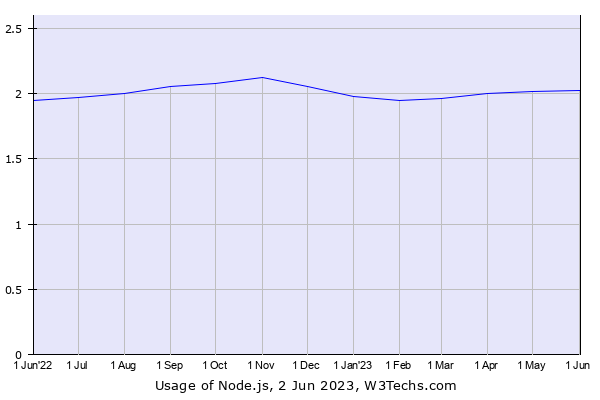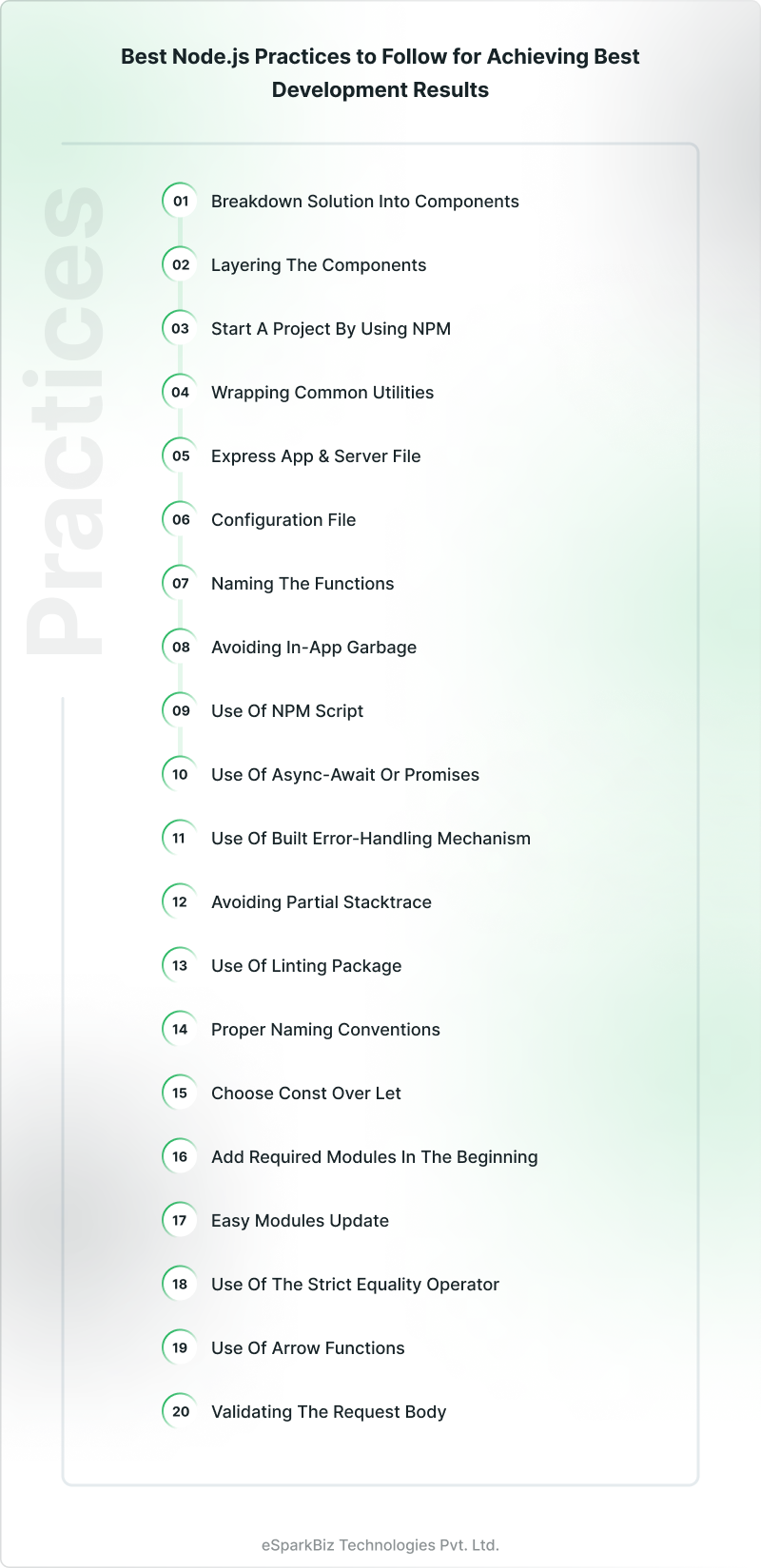Node JS is a popular open-source, single-threaded JavaScript runtime environment used for building scalable and lightweight apps. Both server-side and client-side apps can be built using this framework. About 2% of all websites leverage the Node JS framework.

However, to deliver high-performing and secure apps and ensure exceptional user experience, having an idea of the Node JS best practices is vital. Let’s dive in!
Best Node.js Practices to Follow for Achieving Best Development Results
Some of the most popular Node JS best practices developers must follow are listed below.
1. Breakdown Solution into Components: Easing Large Code Base Handling
Maintaining large applications with a huge code base and a lot of dependencies can be challenging. Whenever you add a new feature, development is likely to slow down. Therefore, one of the best practices is to break down the solution into components.
All you need to do is divide the entire codebase into several smaller components. As a result, each module can have its own folder. It ensures that all modules are small and simple. It makes the whole process easy, and handling large databases is no longer a tough task.
2. Layering the Components: Clear Detection of Performance Issues
Next on the list of Node JS, the best practice is layering the components. That means each of the components must have layers. The layers come with a dedicated object for logic, web, and data access code. It helps separate the performance issues.
Therefore, differentiating processes from test and mock codes becomes easy. As a result, the app’s performance gets accelerated.
3. Start a Project by Using NPM: Generating Packages for Easing the Development Process
One of the best ways to add dependencies or couplings is with NPM. Moreover, NPM can also be used to conveniently browse NodeJS packages. So, make sure to leverage npm in it when starting a new Node JS project.
It can help make the entire development process easier and faster. Ultimately, it will enable you to launch your application early in the market.
4. Wrapping Common Utilities: Eliminating Code Duplication with the NPM Package
In a large project or application, the same code is used multiple times at different locations. Therefore, there is a high chance of code duplication. To avoid this issue, it is an excellent idea to combine them into single private package files. You can use the package at the desired locations in the application.
This helps eliminate code duplication. As a result, managing the codes becomes simple and easy.
5. Express App & Server File: Cutting Down Huge Express Files for Smooth Rendering
Most developers usually define the express application processes for huge files. However, it is a major mistake. Instead, separate the express definition into a minimum of 2 different files.
One of the files can be for network concerns and the other is for API declarations. Moreover, API declarations can be located within several components.
6. Configuration File: Leveraging NPM CONFIG for the Best Security Advantage
One of the significant NodeJS best practices is to keep the app-level keys readable from the environment and file variables. To ensure easy accessibility, creating a config file hierarchy is also important. For all these, a flawless configuration setup is essential.
NodeJS development project structures like nconf, config, and rc can help you achieve this.
Developers must also make the most of the npmrc files for automatically restarting some of the environmental production configurations.
7. Naming the Functions: Simplifying Function Implementation
Another Node JS best practice is to name the functions. It can include callbacks and closures. Try to avoid using anonymous functions.
Instead, use the naming functions. It will make it easy for the developers to implement the function they want and take a snapshot of memory usage.
8. Avoiding In-app Garbage: Optimize Your Garbage Handling
Node JS has a lazy garbage collector. However, its default limit is 1.5 GB. That means it waits for the set memory limit to be achieved and then automatically recovers.
It is best to set the flag on V8 to gain better control over the garbage collector. But running the application with a Docker image can also help. This becomes important especially when the app runs with less memory usage than the set limit.
9. Use of NPM Script: Achieving Automation
In today’s competitive era, faster time-to-market matters a lot. If you want to develop Node JS applications efficiently and quickly, you can use the NPM script. It helps automate several tasks and enhances the workflow.
Also, it allows the development to be completed in much less time. As a result, you can launch the apps faster and gain an edge in the market.
10. Use of Async-await or Promises: A Solution to Error Handling
Using async-await or promises is also one of Node JS best practices. Using the ‘synchronous function’ of JavaScript for several callbacks inside promises for async error handling can lead to a callback hell problem. It is best to consider the JavaScript libraries or async and wait to avoid this performance issue.
The promise functions can help identify potential code errors. It not only makes the code readable but also lowers its complexity.
11. Use of Built Error-handling Mechanism: A Uniform Approach to Error-handling
Different developers use different methods to identify and resolve errors. They may define custom types or use strings. An ideal way to handle errors is to leverage the built-in error object.
It can efficiently handle errors within the source code and open-source JSON packages. Moreover, developers must also log errors, their names, and Meta properties for easy identification.
12. Avoiding Partial Stacktrace: Overcoming Partial Error Information
In the event of an error, whether from an asynchronous or synchronous flow, it is vital to have a full stacktrace. Make sure to avoid partial stacktraces. Because it can provide only partial information for the diagnosis of the problem. Therefore, the result would not be as expected.
13. Use of Linting Package: An Effective Way for Flaw Detection
When it comes to linting packages, there are several tools available. One of the popular packages is ESLint. You can leverage this package to identify potential errors. Moreover, it also enables the developers to check code styles and meet best practice standards.
It helps identify spacing issues that may result in security threats. Apart from that, you can find several other tools for the automatic formatting of codes to improve their readability.
14. Proper Naming Conventions: Simplified Constants, Variables, Functions, & Classes
Using proper naming conventions is also one of the most important Node JS best practices. That is why, you must use all the functions, class names, constants, and variables in lowercase. Use only the full forms and avoid any kind of short forms.
Moreover, it is essential to use an underscore between any two words. It can help improve the security and performance of apps effectively.
15. Choose Const Over Let: Preventing Multiple Use of a Single Variable
It is not possible to change the const variables assigned. So, it prevents multiple uses of a single variable and keeps the code clean. In case you need to re-assign variables, the Let keyword can be used.
But the Let variables have a limited scope. That means they can be accessed only in a particular block. However, the variable declared using var is accessible anywhere inside the function.
16. Add Required Modules in the Beginning: Easy Identification of the File Dependencies
Avoid putting the modules in the middle of a function. Instead, use them only at the beginning. It makes the task of the developers easier and enables them to identify dependencies conveniently. Moreover, it helps avoid several performance issues.
Also Read: In Depth Guide on Cost to Hire Remote NodeJS Developers in 2024
17. Easy Modules Update: Add Required Modules in Folders and Not the Entire File
Many developers have a practice of adding entire files. However, it isn’t the right approach. Instead, it is best to add only the required modules by folder. It becomes easier for the developers to make the desired changes in the future without breaking the contract.
18. Use of the Strict Equality Operator: Achieving Variable Equality
If you want to enhance the security and performance of your Node JS apps, it is vital to use the strict equality operator. Avoid using the weaker abstract equality operator. The strict equality operator ensures that both variables are equal and of the same type.
19. Use of Arrow Functions: Making Code More Concise
The use of Arrow functions allows for making the code more compact and concise. Moreover, it helps retain the lexical context of the root function. Using async-await applications can also stop the application of functional parameters. It significantly enhances the security of applications built with Node JS.
20. Validating the Request Body: Preventing Malicious Content in the Request
Most developers use Joi and other open-source packages to ensure the request body is appropriate and free from any malicious content. Validating all the body and request parameters is essential to meeting the desired schema. It can eliminate the chances of errors and improve the performance of the apps.
Conclusion
By now, you must be well aware of Node JS’s best practices. It is time to leverage and implement them in your next development project. It can eliminate potential flaws and enhance the security and performance of your Node JS apps. So, hire proficient developers and make the most of the Node JS project structure best practices.
Why is eSparkBiz the Ideal Choice for Effective Nodejs Development?
If you are looking to partner with the best Node JS development company, eSparkBiz is the right choice. With more than 12 years of experience in the domain, the company has successfully served 500+ clients in 20 different countries.
Their 370+ highly skilled and experienced developers in the team combine their expertise with the latest technologies to deliver flawless NodeJS development solutions. Collaborate with the developers of eSparkBiz and get the best solutions at competitive prices.
-
When should I use Node JS?
Node JS is ideal for the development of server-side applications. It is suitable for building data-intensive applications.
-
Which are the top Companies using Nodejs?
Several companies use Node JS for app development. The top companies using Node JS include PayPal, Uber, Trello, Medium, eBay, and NASA.
-
Why is NodeJS developer’s favorite?
Node JS is a popular framework among developers owing to its scalability, speed, and efficiency. Moreover, it is also easy to learn.









